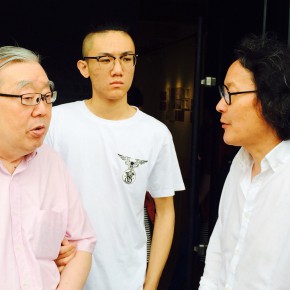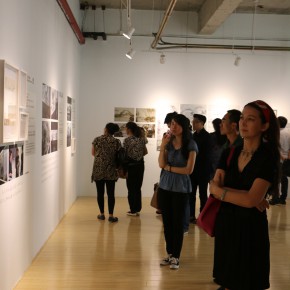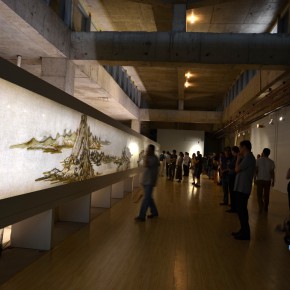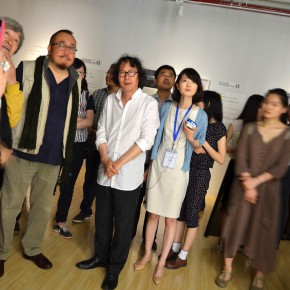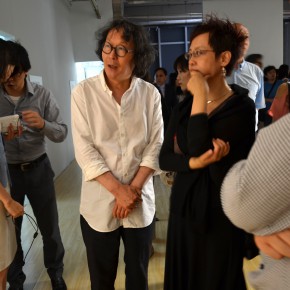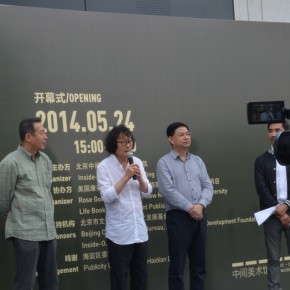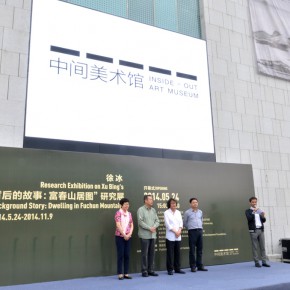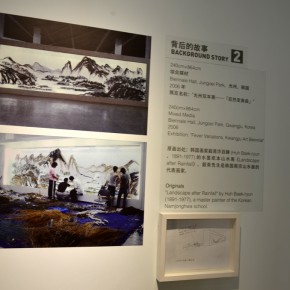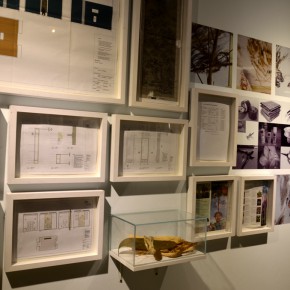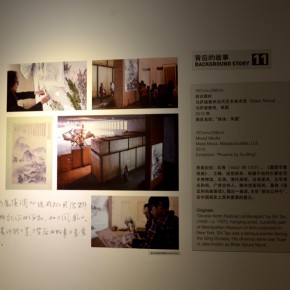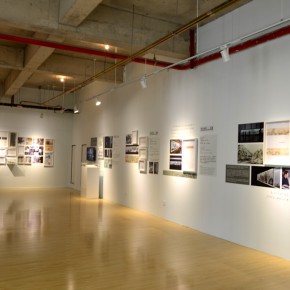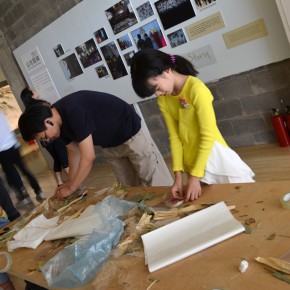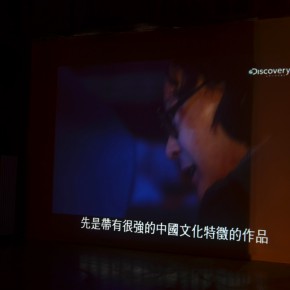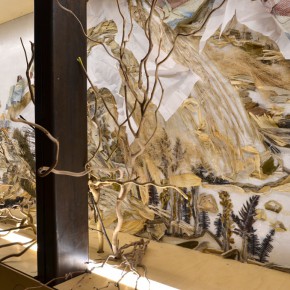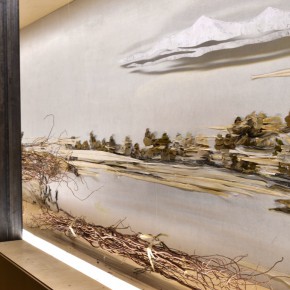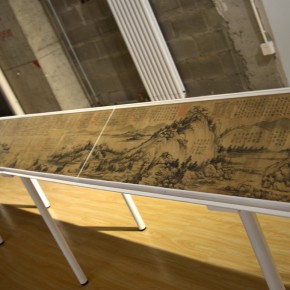,2014,Courtesy-of-Xu-Bing-Studio-Jing-Kai-598x398.jpg)
In the afternoon of May 24, 2014, the Research Exhibition on Xu Bing’s “Background Story: Dwelling in Fuchun Mountains” opened at Inside-Out Art Museum in Beijing, the exhibition is jointly organized by Beijing’s Inside-Out Art Museum and Jing & Kai, co-organized by Rose Goldsen Archive of New Media, Cornell University, Life Bookstore, SDX Joint Publishing Company. The exhibition presents a large amount of literature and research materials of the series entitled “Background Story” created by Xu Bing over the past ten years, as well as the large-scale installation “Background Story: Dwelling in Fuchun Mountains”.
The opening was formally held at 3:00 pm. It was presided over by Zhou Yi, Director of Inside-Out Art Museum, Guan Yu, Deputy Director of Beijing Cultural Affairs Bureau, Qin Changgui, general secretary of Beijing Cultural Development Foundation, Huang Xiaohua, Chairman of Beijing Xishan Industrial Investment Company, Lin Zengwei, Director of the Department of Industrial Development of Beijing Cultural Affairs Bureau, Yu Huayun, Director of Beijing Sculptural Construction Management Office, and other leaders of the municipal party committee, artist Yuan Yunfu and his wife, as well as Haidian District Cultural Promoting Center, Haidian District Museum and chairmen team, the general secretary and the member units of the art industrial alliance, all the directors of the Inside-Out Foundation were also present at the exhibition.
Chinese artist Xu Bing has an international reputation. The international art and critic worlds highly appraise the creation by the artist: “Xu Bing has transcended cultural boundaries, using visual language to express ideas and practical issues.” His works such as “A Book from the Sky” and so on reflect amazing creativity. In 2004, Xu Bing began creating his series of works, “Background Story” just like this. The work first entered the audience’s vision as a remarkable lifelike Chinese landscape painting, but when the spectators circle around to the back of the work, they discover that this landscape painting deploys the use of light, artificial plants, hemp threads, etc., such seemingly ordinary objects. The artist calls this “light painting.” Hereafter, the artist continually experiments with and explores the possibilities within this method of expression, a decade of perfecting the method. Background Story: Dwelling in the Fuchun Mountains is a new step on the scale, concept and method among this series of works.
At the opening ceremony, Xu Bing said he had spent a long time and energy in the exploration of the process of art creation, while it took a great deal of patience to present the effect and the use of materials. “Background Story” is presented on the screen which was constituted through the deployment of light, rather than using painting materials such as canvas, rice paper or pigments to render. Light was more rich and subtle than any material, to directly present, this was a kind of “light painting”, which does not actually appear in the past, but it could create a more abundant and special expression that any category of painting has failed to do in the past.
The exhibition is divided into three parts seperatedly presented on three floors. The ground floor exhibition hall systematically presents images and video material of the 12 sets of “Background Stories” series, as well as abundant manuscripts, so that the spectators have a more in-depth knowledge of the creative process from different angles. At the same time it has a bookstore, and a library for the use of the visitors. On the second floor it is an area for public educational activities, a time-lapse photography area, and small installation show.
About 40 people from 15 families produced a “Background Story” using artificial plants, plastic bags, hemp thread and other materials under the guidance of volunteers. The third floor presents the large-scale installation “Background Story: Dwelling in Fuchun Mountains” which is specially created for the exhibition by the artist, additionally it showcases the facsimile of the original “Dwelling in Fuchun Mountains”, as well as the facsimile of the copy of the original one which was mistaken for the original one by the Emperor Qianlong. In addition, the 3rd floor screens a documentary of Xu Bing shot by the Discovery Channel, which is a part of the Discovery Channel’s first special periodical about artists “Chineseness”, trying to lead the audience towards the world of Xu Bing and his rich art from a more comprehensive perspective.
CAFA ART INFO briefly interviewed Xu Bing about the exhibition on the 3rd floor.
In the process of creating the “Background Story”, how do you find and determine that various materials to present an expected visual effect in different media?Xu: The creation of the“Background Story” series lasted for a decade as I began the creation in Germany, applied imagination to judge it, for example, when I created it in Germany, at the beginning, the distant mountains at the back were made of cotton, thus it didn’t present an effect as mature and rich as the present one. “Background Story” actually adjusts the rays of light in the space, a glass with rice paper recording the status of the light in the space, finally creating an expected painting in the front. Although these materials are different things, the glass makes different materials unified in the relationship of Chinese painting.
The “Background Story” series are created according to many masterpieces, why do you choose to imitate them?
Xu: the “Background Story” series were presented in many domestic and foreign museums over the past ten years, and I usually chose a work according to the collection of the museum, because it would have a relationship with the history of the museum and the local materials.
Some people think that your works belong to the “contemporary ink painting”, what is the category of contemporary ink painting do you think?Xu: Whether it is called new ink painting, or contemporary ink painting, it is an appellation, and it is actually a pseudo subject. Contemporary art often seems to be very immature, because the field, or the expressive way of contemporary art is novel, so that it is a system, or a movement in the process of exploration. Thus it contains both good things and bad things, while it is too young for people to accurately separate themselves according to previous experiences. For ink painting, people have a large number of experiences trying to make the technique more mature. New ink painting strives to break away from the mature system, thus it is in a very embarrassing context.
So, do you think that “new ink painting” or “contemporary ink painting” can’t be simply defined with the use of material?Xu: In fact, whether using ink or not isn’t the issue at the core, while the most important thing is what the artist wants to express. It is necessary to think of what material does well in the presentation of the expected effect and the words of the artist. It may be a new language that no one speaks, it is a new language of the time, so it is in need of finding a new way of speaking in order to accurately express.
The exhibition will continue until November 2014.
About the artist
Xu Bing, internationally renowned artist; graduated from Central Academy of Fine Arts in 1981, Vice President of the Central Academy of Fine Arts; he became famous for being the creator of “Tianshu” which no one can understand. From “Tianshu” to “Dishu”, these linguistic works constitute a major thread in the interpretation to his art. Moreover, his creation of Background Story series (2004 - ), Phoenix (2007 – 2010), Travelling to the Wonderland (2013), and other large installation pieces which transform everyday objects into something special, languages that are exotic and full of tension, and linguistic types of works that provide commentary on each other have become another thread of inner clarity for Xu Bing’s art. His works have been presented at a large number of art institutions such as the Metropolitan Museum of Art in New York, The British Museum in London, The Louvre Museum in France, The Museum of Modern Art in New York, V&A Museum in London, Venice Biennale, etc.
Courtesy of the artist and Inside-Out Art Museum, translated by Chen Peihua and edited by Sue/CAFA ART INFO.


,2014,Courtesy-of-Xu-Bing-Studio-Jing-Kai1-290x290.jpg)
,2014,Courtesy-of-Xu-Bing-Studio-Jing-Kai1-290x290.jpg)
,2014,Courtesy-of-Xu-Bing-Studio-Jing-Kai1-290x290.jpg)
,2014,Courtesy-of-Xu-Bing-Studio-Jing-Kai1-290x290.jpg)
,2014,Courtesy-of-Xu-Bing-Studio-Jing-Kai1-290x290.jpg)
,2014,Courtesy-of-Xu-Bing-Studio-Jing-Kai1-290x290.jpg)

